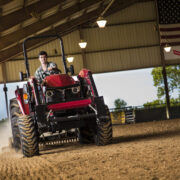Takeaways From A Weekend in Ocala With Eventing Pros

I was lucky enough to attend the Florida Horse Trials Association annual CAMP, a 2-day clinic jam-packed with riding and unmounted learning sessions from a slew of talented eventing professionals.
This was the adult amateur summer camp I’ve been longing for. I met so many fun and kind adult riders and their lovely horses. When we weren’t riding, we were getting to know each other and swapping stories over wine and pizza back at the barns.
I took my 11-year-old Thoroughbred gelding, Mikey, to the clinic, where we rode in dressage, show jumping and cross-country with other Novice-level riders at the gorgeous Majestic Oaks Ocala Farm eventing venue. Here are some of the takeaways I learned from the pros who helped Mikey and I over the weekend.
Give up already with the ‘chuck and cluck’.
During a show jumping session with American Olympian Jill Henneberg, we broke down a fairly standard stadium course with a two-stride, one-stride, and plenty of bending line combinations into various sections before putting all the pieces together. To begin, Jill had us canter over a series of figure-eight-like cavaletti exercises to get our horses sharp and on the aids.
As the jumping session wore on, naturally some horse began to tire. But Jill was quick to correct any of us who tried to do more with our bodies to “help” our horses get over the fences. You know what I’m saying – lifting our hands too much, jumping up their neck, and the dreaded cow-kicking and chucking the reins leading up to the base of the fence when a natural distance doesn’t materialize.
Jill said this latter method, while honest in our intentions, is actually a safety concern. By pushing the horse to lengthen with just a short amount of ground to cover before the fence, we’re setting them up to hang a leg (or pull a rail, in the case of show jumping). Instead of clucking and chucking the reins, we should focus on rebalancing them as much as we can, Jill explained, and stay quiet with our bodies so they can do their job of getting over the fence as accurately and safely as they can.
Seat security trumps equitation.
Sticking with this safety theme, WEG silver medalist Dorothy Crowell focused on developing a secure cross-country riding position, both while galloping and over fences, at the clinic. We worked on sitting deeply (think: on your seat pockets) in the strides leading up to a solid fence and staying open in our knees and hips to round in our lower backs. This position helps us stay with or slightly behind the horse’s movement, keeping us balanced and secure.
I’ll admit it – I struggled with this. It was hard for me to not be stiff in my lower back after years of riding in the hunters and equitation. But equitation is not the name of the game in good cross-country riding. Safety and security is!
There’s no such thing as a ‘low palate’.
During an unmounted ‘lunch and learn’ session of the first day of the clinic, Dr. Bess Darrow, an equine veterinarian who specializes in dentistry, gave an informative bit and bridle fitting demonstration. During this lecture, she dispelled many myths about proper bit and bridle fitting, and how the anatomy of the horse’s head and mouth plays a role in how we communicate with them under tack.
One of the more common myths she hears from clients is trouble fitting a bit for a horse with a “low palate.” No horse, Dr. Darrow said, has a low palate. Different horses can have varying needs and require different fitting tack, but the palate is the same. So be cautious of any bit or product that is marketed to address a specific problem, and instead focus on finding equipment that fits well for your specific horse.
Sometimes, you’ve got to risk it.
For dressage, clinic participants performed a ride-a-test with Megan McGee, a USEF licensed official, USDF “R” eventing judge and FEI chief steward for eventing and dressage. During my individualized time with Megan, she gave me some smart and quick ways to add a half-point to a point to some movements in my dressage test. But the biggest takeaway I got from Megan was don’t be afraid to take a risk.
She urged me to push my horse more forward in the trot to truly show him off, even offering some lenthenings on centerline and diagonal lines. Showing off my horse with more pace would improve the overall cadence of the test and demonstrate his adjustability in the transitions.
After our first ride-a-test, we came back and rode the test again in a fun and casual combined test with other clinic participants. I took Megan’s advice and pushed for more in my test. There were a few bobbles, but Megan said a judge is more likely to reward the better gait with a mistake for a stride or two over a fairly consistent, but less impressive way of going. Ultimately, she gave us a 27.1 for our efforts, which I was pleased with!
Photo credit: Keli Wakeley Photography


